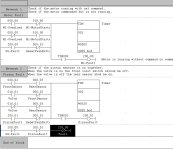Hester
Member
Equipment Failure Diagnostics and Fault Prevention via the PLC:
What are your favorite troubleshooting and Fault Prevention routines that you build into your PLC code?
I’m new and know very little about PLC programming, so while I come up to speed, would the guru’s give me a little latitude, because I admit upfront I know very little, and could use your help. My background is electronics hardware with some VB, VBA, C++, and OOP exposure. But I do not consider myself a very good programmer – I only have the desire to be better. BTW, I love this site. It is so helpful. Thanks!
I’m looking for diagnostic / fault prevention ideas such as:
Photo Eye Make and Break Logic:
http://www.mrplc.com/kb/index.php?page=index_v2&id=15&c=12
or Best Practices such as “Industrial Safety Control” by Jim Rowell:
http://www.mrplc.com/kb/index.php?page=index_v2&id=44&c=38
This article link provided by dandrade is good but is more academic than my current needs.
http://www.viverautomacao.net/Anexos/fault.pdf
Any messaging best practices would be appreciated too.
Thanks guys for the help.
What are your favorite troubleshooting and Fault Prevention routines that you build into your PLC code?
I’m new and know very little about PLC programming, so while I come up to speed, would the guru’s give me a little latitude, because I admit upfront I know very little, and could use your help. My background is electronics hardware with some VB, VBA, C++, and OOP exposure. But I do not consider myself a very good programmer – I only have the desire to be better. BTW, I love this site. It is so helpful. Thanks!
I’m looking for diagnostic / fault prevention ideas such as:
Photo Eye Make and Break Logic:
http://www.mrplc.com/kb/index.php?page=index_v2&id=15&c=12
or Best Practices such as “Industrial Safety Control” by Jim Rowell:
http://www.mrplc.com/kb/index.php?page=index_v2&id=44&c=38
This article link provided by dandrade is good but is more academic than my current needs.
http://www.viverautomacao.net/Anexos/fault.pdf
Any messaging best practices would be appreciated too.
Thanks guys for the help.










